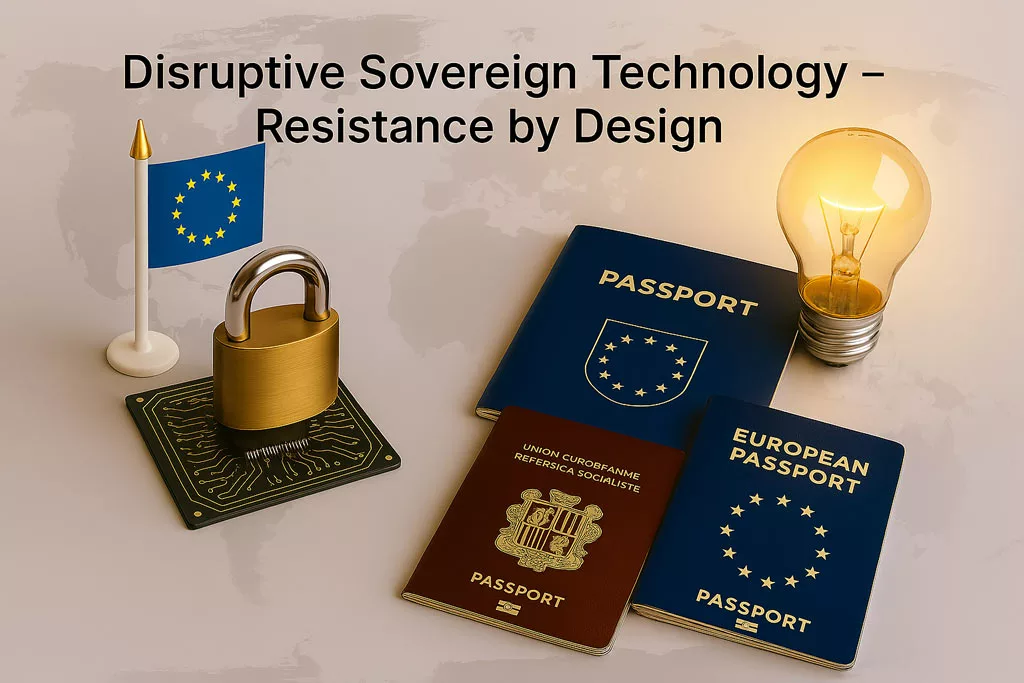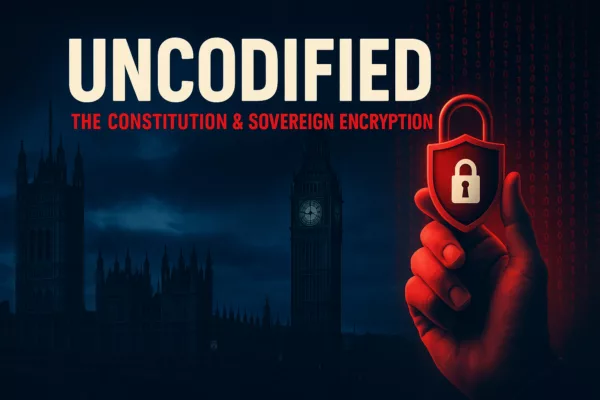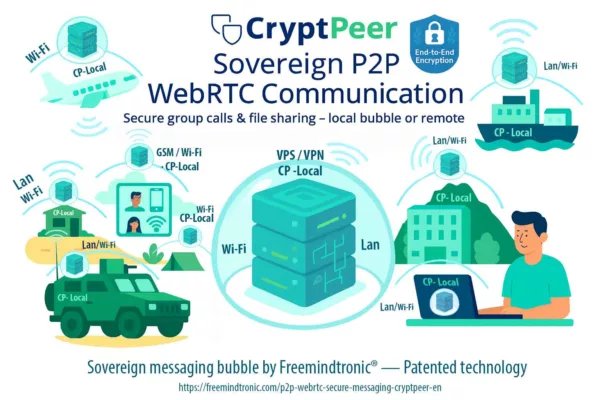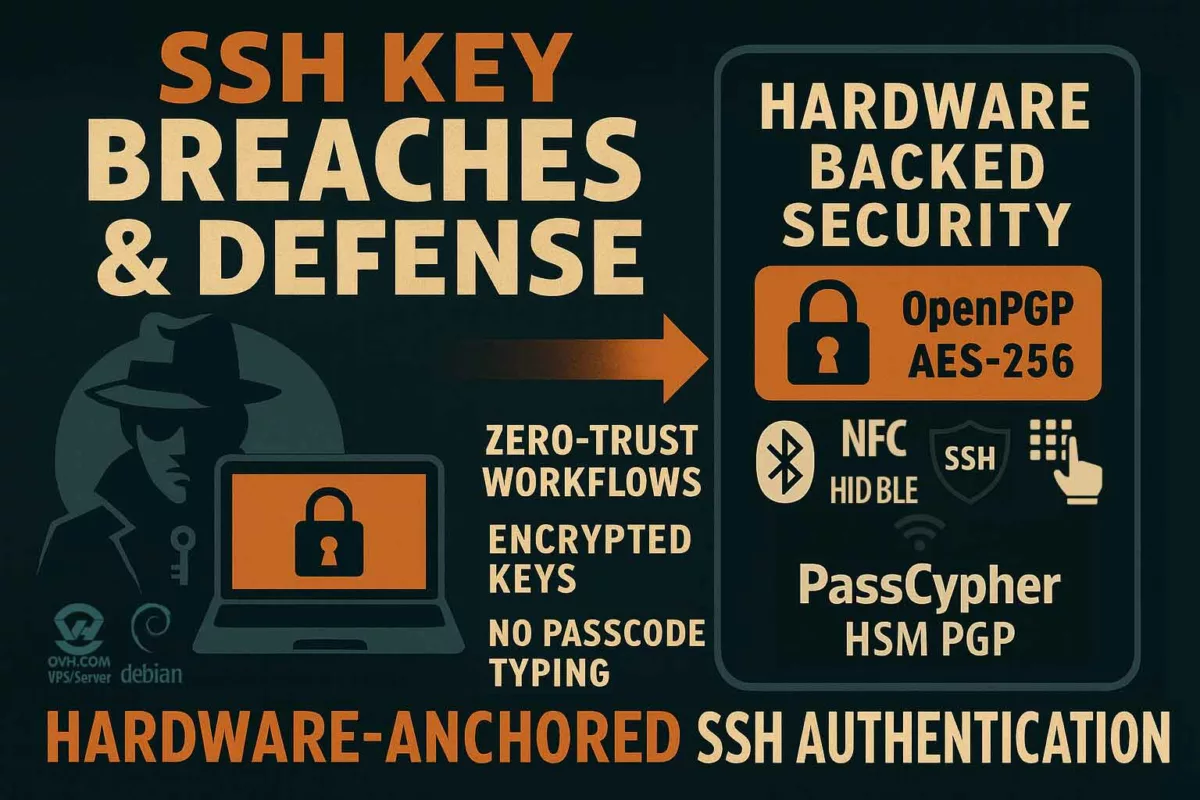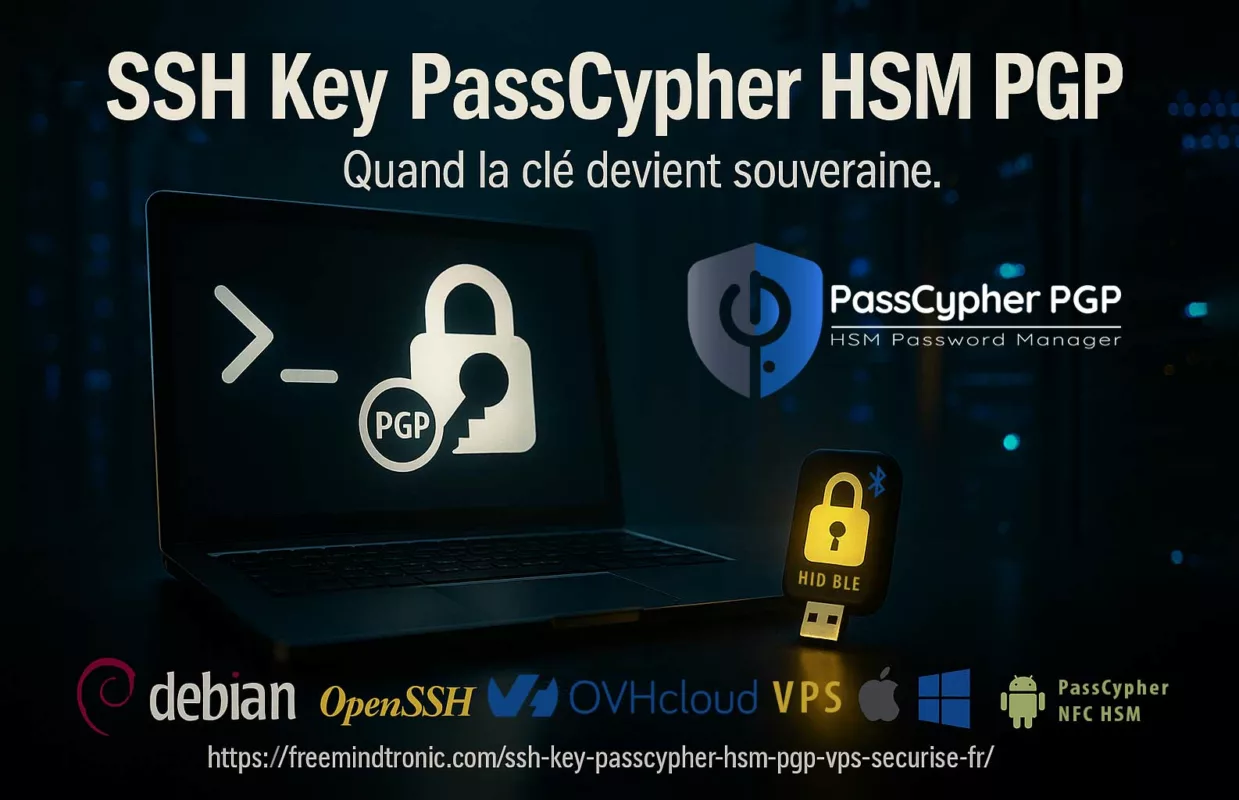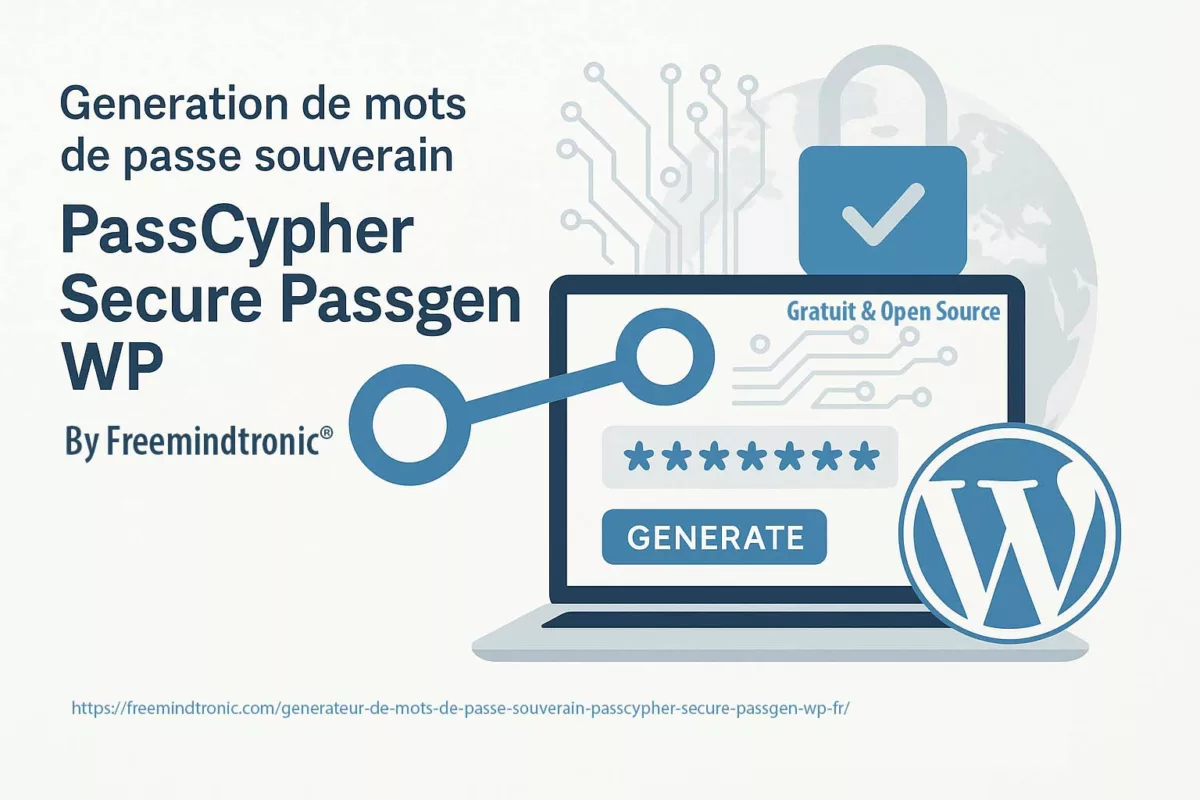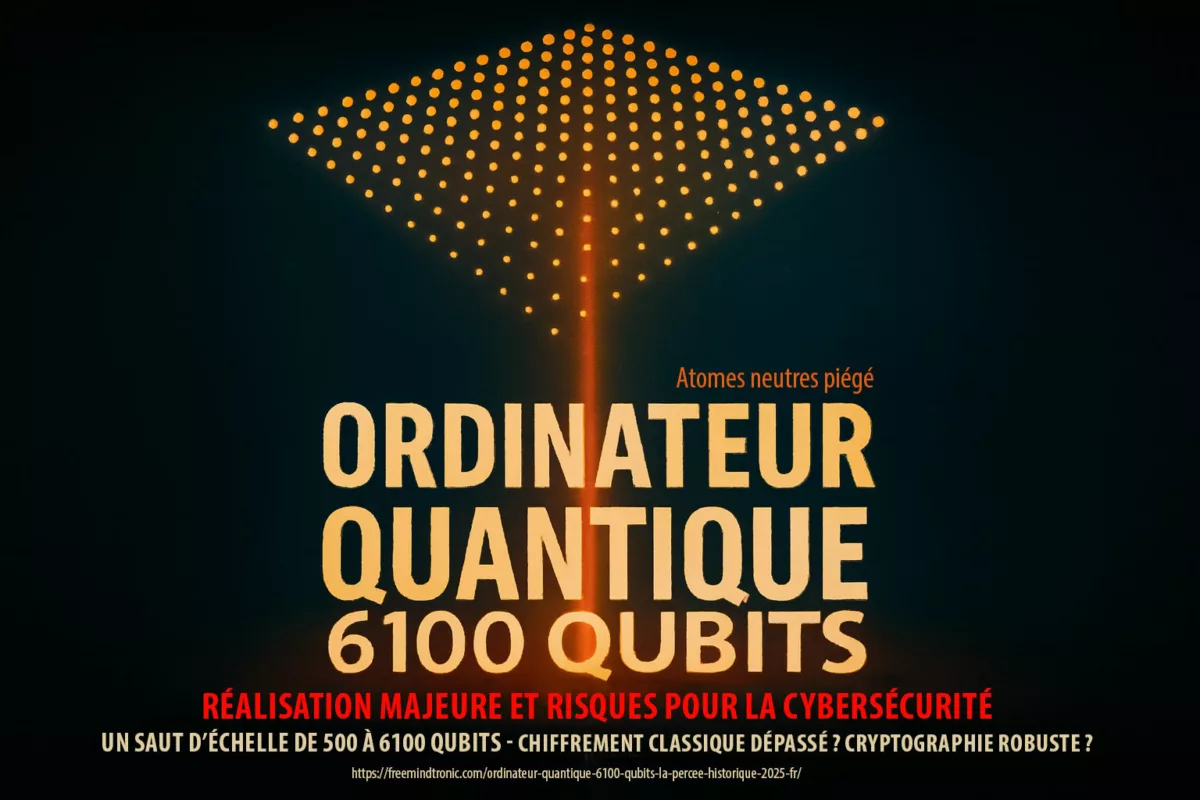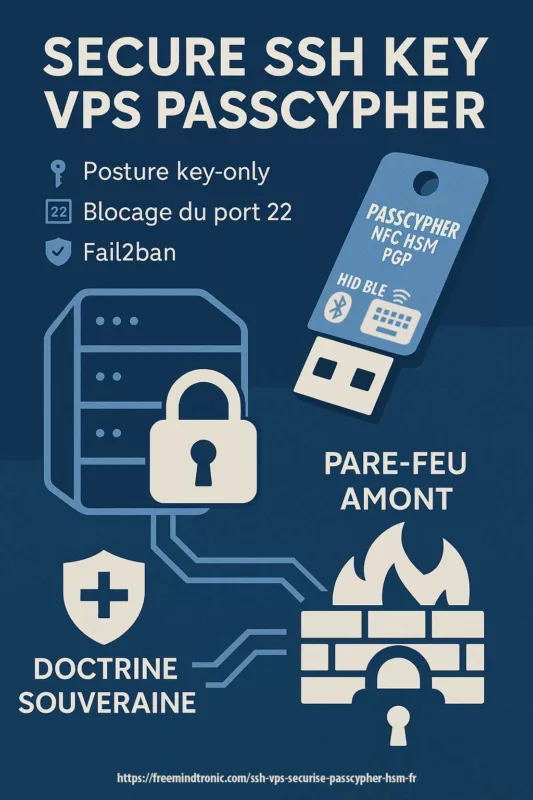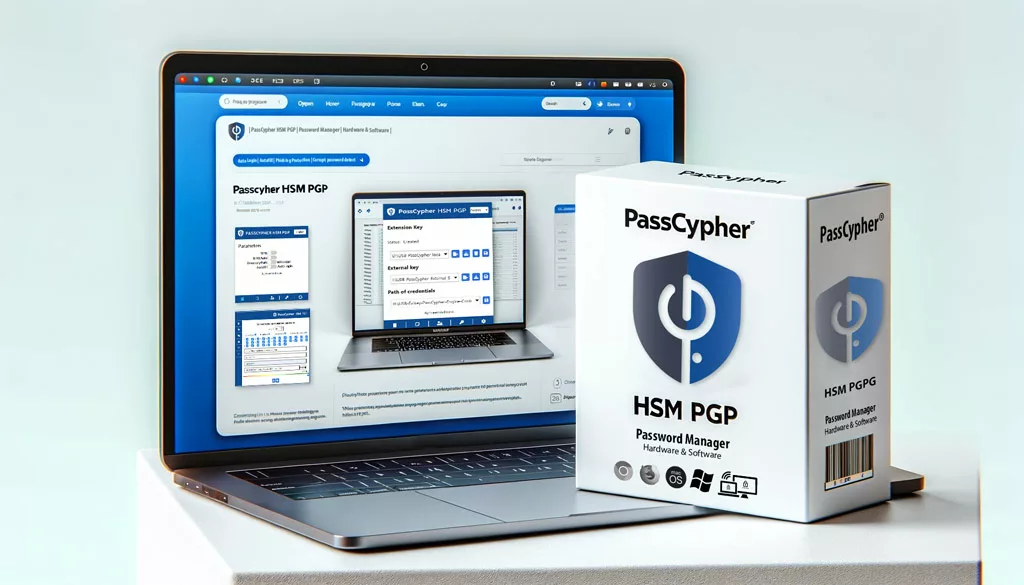Innovation of rupture is not simply a bold invention—it’s a shift in power, usage, and norms. This article explores two dominant visions of innovation, the role patents play in enabling or constraining breakthroughs, and the systemic resistance that disruptors must navigate. Using Freemindtronic’s sovereign cybersecurity technologies as a real-world case, we analyze how regulatory inertia, industrial dependencies, and biased standards affect the path to adoption. Anchored in field experience and strategic reflection, this narrative offers a vision of innovation that is resilient, disruptive, and sovereign by design.
About the author — Jacques Gascuel is the inventor and founder of Freemindtronic Andorra, where he pioneers disruptive sovereign cybersecurity technologies based on patented architectures. With a legal background and a strategic mindset, he explores how hardware-based security and normative resistance intersect in sovereign contexts. His work focuses on building autonomous systems — offline, OS-independent, and resilient by design — to address the systemic inertia in regulated environments. Through his publications, Jacques bridges field innovation, legal asymmetry, and technological sovereignty, offering a vision of cybersecurity that breaks compliance boundaries without compromising purpose.
Disruptive innovation doesn’t bloom from comfort. It emerges where certainties tremble—when new visions confront the inertia of accepted norms. In today’s strategic landscape, where sovereignty meets cybersecurity and systemic inertia blocks transformation, innovation of rupture becomes more than a buzzword. It’s a tension between evolving what exists and inventing what doesn’t. Many organizations believe innovation must adapt to existing frameworks. Others argue real progress demands defiance—crafting new usage models, new markets, and entirely new expectations. This friction fuels the deeper dilemma: should innovators conform to dominant systems or design alternatives that reshape the rules? In practice, innovation of rupture sits at this crossroads. It alters market structures, redefines user behaviors, and demands new regulatory thinking. But to disrupt effectively, it must challenge more than just technical limitations. It must shake habits, belief systems, and institutional dependencies. This article explores: While patents are commonly viewed as tools for safeguarding innovation, they rarely ensure its success. A patent may shield an idea from duplication, but it does not compel the market to embrace it. This tension is especially true for innovations of rupture, which often disrupt comfortable norms and threaten entrenched interests. Patents are legal instruments designed to grant inventors exclusive rights over their creations. They protect intellectual property, encourage investment, and often strengthen negotiation power. Yet, as powerful as patents are on paper, they do not automatically accelerate adoption. A patented disruptive technology may languish if it collides with regulatory inertia or lacks strategic alignment. 👉 According to the European Patent Office (EPO), over 50% of patents never make it to market. That figure increases when the technology challenges dominant standards or requires user behavior change. When disruption alters usage patterns or demands new norms, patents become part of a broader strategy—not a safety net. For instance, sovereign cybersecurity tools that operate without OS dependency or cloud access may bypass known frameworks entirely. In doing so, they risk clashing with legislation and standards designed around centralized control. 📌 Consider this: a patented sovereign security device offers offline encryption, no RAM exposure, and total independence. But if legal frameworks mandate auditability through centralized servers, the disruptive power becomes paradoxical—it’s secured by law yet suppressed by law. Innovation of rupture thrives only when the patent’s protection aligns with market readiness, user context, and communication strategy. Adoption requires more than exclusivity—it calls for trust, usability, and perceived legitimacy. The patent may block competitors, but only strategic narrative enables traction. As we move forward, it becomes clear that even well-protected inventions need to confront a larger force: systemic resistance driven by lobbying, standards, and industrial dependencies. Even the most visionary innovations are rarely welcomed with open arms. When a technology disrupts existing structures or threatens entrenched powers, it enters an ecosystem where resistance is embedded. Systemic forces—legislative inertia, industrial dependencies, and hidden lobbying—work collectively to defend the status quo. And this resistance doesn’t always wear a uniform. Sometimes it looks like compliance. Other times it’s masked as best practices. Standards are designed to harmonize markets, ensure safety, and guide interoperability. Yet in practice, some norms are shaped by dominant players to protect their advantage. When a disruptive technology operates outside conventional OS frameworks, centralized infrastructure, or cloud ecosystems, it may be deemed non-compliant—not because it is unsafe, but because it is independent. Strategic disobedience then becomes a necessity, not a weakness. The power of lobbying often lies in its subtlety. Through influence on advisory boards, standardization committees, or regulatory language, certain entities steer innovation in directions favorable to existing infrastructures. As reported in the OECD’s regulatory innovation framework, this type of resistance can stall sovereign solutions under the guise of safety, stability, or ecosystem integrity. Large-scale institutions—whether governmental, financial, or industrial—build upon legacy systems that are expensive to replace. Technologies that challenge those infrastructures often face delayed integration, skepticism, or exclusion. Sovereign cybersecurity tools, for instance, may offer superior decentralization, but if the ecosystem demands centralized logging or remote validation, their deployment becomes politically complex. In theory, disruptive innovation sparks transformation. In practice, it challenges conventions head-on. Freemindtronic’s sovereign cybersecurity solutions demonstrate what happens when disruption refuses to conform. Designed to operate fully offline, independent of operating systems or cloud infrastructure, these hybrid HSMs (Hardware Security Modules) embody true innovation of rupture. They don’t just secure — they redefine the terms of security itself. Freemindtronic’s DataShielder NFC HSM devices offer autonomous encryption, air-gapped by design. Credentials and cryptographic operations remain insulated from operating systems, RAM, and clipboard exposure — a direct response to threats like Atomic Stealer (AMOS), which weaponize native OS behaviors. This sovereign architecture decentralizes trust, eliminates third-party dependencies, and removes the attack surface exploited by memory-based malware. In a landscape where cybersecurity often means cloud integration and centralized monitoring, Freemindtronic’s solution is strategically disobedient. Despite its resilience and privacy-by-design principle, this type of sovereign hardware often encounters systemic resistance. Why? Because mainstream standards favor interoperability through centralized systems. Secure messaging protocols, compliance tools, and authentication flows assume OS/cloud integration. A device that deliberately avoids those channels may be seen as “non-compliant” — even when it’s demonstrably more secure. For Freemindtronic, rupture is not a side effect — it’s a strategic direction. By embedding sovereignty at the hardware level, the company redefines what cybersecurity means in hostile environments, mobility constraints, and regulatory asymmetry. Patents protect the technical methods. Field validation confirms operational effectiveness. But the real challenge lies in aligning this innovation with institutions still tethered to centralized control. Innovation of rupture offers strategic independence—but when used maliciously or without accountability, it can destabilize sovereign balance. Technologies designed for autonomy and security may become instruments of opacity, evasion, or even asymmetrical disruption. Furtive devices that bypass OS, cloud, and traceability protocols pose new ethical and political dilemmas. While sovereign tools empower users, they may also obstruct lawful oversight. This paradox reveals the fragility of digital sovereignty: the very features that protect against surveillance can be weaponized against institutions. If rupture becomes uncontrolled stealth, sovereignty turns inward—and may erode from within. State actors must balance innovation support with strategic safeguards. Furtive tech, if exploited by criminal networks or hostile entities, could bypass national defense, disrupt digital infrastructure, or undermine democratic mechanisms. The challenge is to maintain sovereignty without losing visibility. The answer is not to suppress rupture, but to govern its implications. Innovation must remain open—but the usage contexts must be anticipated, the risks modeled, and the countermeasures embedded. Otherwise, strategic disobedience may mutate into strategic evasion. In environments shaped by digital surveillance and institutional control, sovereign technologies must do more than protect — they must resist. Freemindtronic’s HSM architectures do not rely on operating systems, cloud, or centralized protocols. Their independence is not incidental — it is intentional. These devices stand as natural barriers against intrusion, espionage, and normative capture. By operating offline, memory-free, and protocol-neutral, these sovereign systems form natural countermeasures against technical espionage. At the institutional level, they resist interception, logging, and backend exploitation. At the individual level, they preserve digital autonomy, shield private credentials, and deny access vectors that compromise sovereignty. This architecture doesn’t just avoid surveillance — it actively denies the mechanisms that enable it. In doing so, it redefines the notion of defensive security: not as passive protection, but as active strategic disobedience. Sovereign HSMs like those from Freemindtronic don’t block threats — they render them inoperative. The CIA’s 2022 study on cyber deterrence recognizes that disruption of espionage pathways is more effective than traditional deterrence. Similarly, Columbia SIPA’s Cyber Disruptions Dataset catalogs how sovereign tech can neutralize even state-level surveillance strategies. Not all rupture starts by defying the frame. Sometimes, it emerges from strategic differentiation within existing norms. The Boxilumix® technology developed by Asclepios Tech exemplifies this pathway: it doesn’t reject post-harvest treatment—it reimagines it through light modulation, without chemicals. Boxilumix® respects regulatory frameworks yet achieves measurable innovation: longer shelf life, improved appearance, enhanced nutritional value. These advancements address stringent export demands and create value without entering regulatory conflict. Their approach earned high-level validation: Seal of Excellence (European Commission), Booster Agrotech (Business France), and multiple awards for sustainable food innovation. It proves that innovation of rupture can also arise from mastering differentiation, not just rebellion. Whether through institutional challenge or smart alignment, innovation succeeds when it balances context, purpose, and narrative. Asclepios Tech shows that rupture can be elegant, embodied through precision rather than force. Inventing is never enough. For innovation of rupture to matter, it must be adopted—and for adoption to happen, strategy must shape perception. Disruptive technologies don’t just fight technical inertia; they challenge political, cultural, and institutional expectations. Without a compelling narrative, even the most sovereign innovation remains marginal. Innovators often underestimate how tightly trust is bound to context. A sovereign security device may prove resilient in lab conditions, but if users, regulators, or institutions lack visibility into its methods or relevance, adoption slows. Disruption must speak the language of its environment—whether that’s national sovereignty, data protection, or resilience in critical infrastructure. A powerful narrative aligns the innovation with deeper social and institutional needs. It must translate disruption into clarity—not just for engineers, but for decision-makers, legal analysts, and end users. The message must express purpose, urgency, and credible differentiation. Long before markets shift, minds must be convinced. Creating new usage is more strategic than improving old ones. Sovereign cybersecurity tools succeed when they’re not just better, but necessary. Frictionless integration, context-aware functions, and layered utility drive usage organically. Once a tool shapes how people behave, it reshapes how industries and institutions respond. To thrive amid systemic blockers, innovators must anticipate regulatory gaps, industrial dependencies, and political asymmetries. Strategic rupture doesn’t mean isolation—it requires calibrated tension. By preparing answers to compliance queries, forging alternative trust models, and demonstrating social impact, the innovator positions disruption not as rebellion but as solution. Far from being speculative, the concept of innovation of rupture and technological sovereignty is increasingly echoed in global institutional and academic discourse. Recent studies expose how lobbying, standardization politics, and intellectual property systems can hinder strategic adoption. The need for independent frameworks, sovereign infrastructures, and regulatory agility is no longer just theoretical—it’s an emerging priority. The OECD report “Lobbying in the 21st Century” (2021) reveals how influential actors shape regulatory norms to sustain dominant business models. This aligns with our earlier analysis: disruption often faces resistance dressed as “standards.” Transparency International’s statement on OECD lobbying reforms warns of “unregulated influence ecosystems” that may suppress sovereign technologies before public adoption begins. The German institute Fraunhofer ISI defines technological sovereignty as the capacity to “make independent technological choices” in strategically sensitive domains. Their report underscores the role of rupture in escaping dependency traps — especially in digital infrastructure. Dutch research center TNO’s whitepaper details how decentralized, sovereign cybersecurity tools strengthen resilience. Offline hardware models — as exemplified by Freemindtronic — are cited as viable alternatives to cloud-based dependencies. The Stockholm School of Economics provides a detailed thesis on patent limitations: “The Impact of the Patent System on Innovation” by Julian Boulanger explains how patents fail when they lack socio-regulatory traction. Further, Télécom ParisTech’s thesis by Serge Pajak “La propriété intellectuelle et l’innovation” explores how innovation of rupture faces challenges when legal frameworks are not strategically aligned. An EU-wide study by Frontiers in Political Science “Digital Sovereignty and Strategic Autonomy” analyzes conflicts between national interest and imposed technical standards. It confirms what field innovators already know: real sovereignty often requires navigating beneath the surface of compatibility and compliance. The vision behind innovation of rupture is not isolated—it is increasingly echoed across high-level institutions, deeptech policy reports, and academic research. Sovereignty, disobedience by design, and resistance to normative capture are themes gaining traction in both state-level and multilateral contexts. Below is a curated set of official studies, whitepapers, and theses that lend credibility and depth to the disruptive sovereignty framework. The OECD’s report “Lobbying in the 21st Century” highlights how technical standards and regulatory influence are often shaped to favor incumbents. Norms may reflect ecosystem biases, not innovation potential. Transparency International further warns that unregulated influence ecosystems suppress sovereign technologies under the guise of compliance. Fraunhofer Institute’s 2021 paper frames sovereignty as the ability to make independent choices in tech-critical areas. It recognizes rupture as a mechanism to escape dependency traps and enhance strategic autonomy. The Dutch innovation hub TNO lays out clear alternatives to cloud-centric security in its 2024 whitepaper “Cybersecurity and Digital Sovereignty”. It cites air-gapped HSMs as foundational elements of resilience—a core tenet of Freemindtronic’s technology. The DGE’s Deeptech 2025 report defines innovation of rupture as a strategic lever to address industrial sovereignty, cybersecurity, and supply chain independence. It calls for regulatory flexibility and intellectual property reforms to enable adoption. In Springer’s 2024 monograph “Cyber Sovereignty”, researchers analyze how digital sovereignty is used by nations to reassert control in fragmented and unregulated technological ecosystems. It positions rupture as both political and technical strategy. Frontiers in Political Science explores the friction between pan-European norms and national digital autonomy. It validates sovereign hardware and non-cloud infrastructures as legitimate modes of technological independence. Sovereignty doesn’t exclude collaboration. As argued in Intereconomics’ article “Coopetitive Technological Sovereignty”, strategic autonomy may be best achieved by choosing productive interdependence—where innovation remains independent, but dialogue continues. Disruption without sovereignty is often short-lived. True rupture begins when innovation no longer seeks validation from the systems it challenges. As we’ve seen, patents offer protection but not traction, standards can ossify into gatekeeping tools, and market adoption demands a layered strategy. But beyond technique lies posture—a deliberate alignment between vision and action, even when action diverges from dominant models. Strategic disobedience is not recklessness—it’s methodical. It means identifying systemic bottlenecks, assessing normative traps, and crafting technologies that are contextually aware yet structurally independent. Sovereign tools do not just perform—they resist absorption. And for inventors operating at the frontier, that resistance is not a flaw but a function. Technological rupture often unsettles the familiar. It may provoke critique, trigger lobbying pushback, or be framed as “unusual.” But redefinition is born in discomfort. Freemindtronic’s example proves that by designing for autonomy and resilience, innovation can sidestep fragility and embrace sovereignty—not as a theme, but as a framework. This perspective is not closed—it’s open to interpretation, continuation, and even contradiction. Disruptive sovereignty is not a monologue. It’s a strategic invitation to reimagine innovation beyond compatibility, beyond compliance, and beyond control. It calls inventors, policymakers, and tech leaders to embody a form of creation that respects context but isn’t bound by it.Executive Summary
Strategic Reading Guide
Key Strategic Takeaways
Innovation beyond comfort zones
The Patent Paradox: Protection vs Adoption
Protection without traction
Innovation of rupture meets legal friction
Strategic alignment matters
Systemic Resistance: Lobbying, Norms and Market Inertia
Norms as strategic control mechanisms
Lobbying as invisible resistance
Legacy dependencies and institutional inertia
When norms are crafted around centralized control, true sovereignty looks disruptive. And disruption, by design, resists permission.Case Study – Freemindtronic and Sovereign HSM Disruption
Security without OS or cloud dependency
A technology that challenges normative ecosystems
Strategic positioning amid systemic resistance
Freemindtronic’s sovereign HSMs don’t just defend against threats — they reject the frameworks that enable them. That’s where rupture becomes strategy.Risks of Rupture – When Sovereign Technology Challenges Sovereignty Itself
Between emancipation and erosion
National interest and digital asymmetry
Proactive governance over sovereign tools
Without contextual safeguards, innovation of rupture risks becoming a vehicle for sovereignty denial—not reinforcement.Disruptive Counter-Espionage – Sovereignty by Design
Natural sovereignty barriers: institutional and individual
Espionage denial as strategic posture
Global recognition of disruption as countermeasure
Whether institutional or personal, sovereignty begins where espionage ends. Freemindtronic’s rupture model isn’t a shield. It’s a denial of exposure.Innovation Between Differentiation and Disruption
Conforming without compromising innovation
Recognition through integration
Strategic lesson — arbitrating innovation paths
Sometimes, the most strategic disruption is knowing how to differentiate—without leaving the frame entirely.Strategic Adoption: Making Rupture Acceptable
Context drives legitimacy
Storytelling as strategic infrastructure
Usage as a trigger of adoption
Tactical alignment with resistance
Visibility, narrative, and context make rupture acceptable—even when it remains strategically disobedient.Institutional and Academic Validation of Disruptive Sovereignty
OECD – Lobbying and normative bias
Fraunhofer ISI – Technology sovereignty as policy framework
TNO – Autonomy and digital resilience
Academic theses – Patents and resistance strategies
EU studies – Strategic autonomy and sovereignty
From OECD to Fraunhofer, EU institutions to doctoral research, the call for sovereignty in innovation is growing. Freemindtronic’s model is not fringe—it’s frontline.Strategic Validation — When Institutions and Research Confirm the Sovereign Path
OECD – Lobbying and Normative Resistance
Fraunhofer ISI – Defining Technology Sovereignty
TNO – Sovereign Cybersecurity Architectures
France – Deeptech and Sovereign Innovation Strategy
Springer – Cyber Sovereignty and Global Power Shifts
Frontiers – EU and Strategic Autonomy
Academic Theses – Patents and Resistance Mechanics
Towards Coopetitive Sovereignty
From OECD and Fraunhofer to EU bodies and French industrial strategy, your thesis is not just visionary—it’s reflected in the architecture of future innovation governance.Towards Disruptive Sovereignty – A Strategic Perspective
The role of the inventor: method over compliance
Accept discomfort, pursue redefinition
From strategic insight to collective movement
To disrupt meaningfully, innovators must stop asking for permission—and start building what permission never allowed.
Tag Archives: offline security
2024 MFA Price Comparison: Affordable 2FA for Businesses and Best OTP Solutions for Secure Management
The Best 2FA MFA Solutions, including affordable 2FA for businesses, are essential for securing your digital life in 2024. From managing TOTP/HOTP keys offline to ensuring end-to-end anonymity, discover the top tools that provide advanced security features without relying on cloud storage. Explore how these solutions safeguard your accounts with ease and reliability.
Stay informed with our posts dedicated to Technical News to track its evolution through our regularly updated topics.
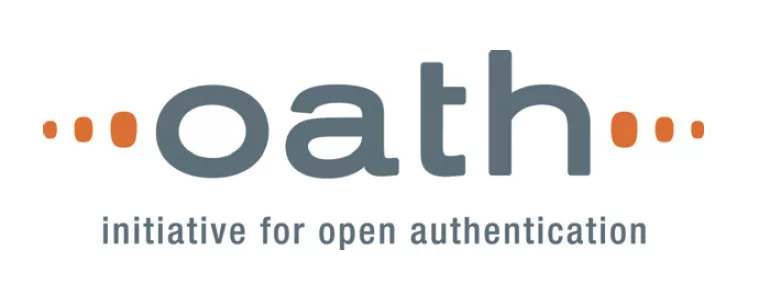
Best TOTP/HOTP Management Solutions for 2024
In this post, we’ll compare the best OTP solutions in 2024, highlighting their ability to store, manage, and share OTP keys securely. The unique advantage of solutions like PassCypher NFC HSM is their ability to manage keys offline, ensuring air-gapped security and quantum-resistant encryption for long-term protection.
Top Authentication Tools for Secure OTP Management
PassCypher NFC HSM stands out as a hybrid hardware and software solution that manages both TOTP and HOTP keys. Its AES-256 CBC encryption ensures that secret OTP keys and login credentials are stored securely, using segmented keys and customizable trust criteria (e.g., geographical zones, PINs, or fingerprints).
In addition to secure key management, PassCypher NFC HSM simplifies the process of generating and managing PINs. Users can generate a PIN automatically by simply clicking on the secret key label via their NFC-enabled phone. This interaction remains contactless, making it incredibly convenient to copy and paste the PIN directly into their device or manually input it on their computer. This user-friendly feature allows for quick and secure access without compromising on security.
RSA-4096 encryption is utilized only for secure sharing of these secrets between NFC HSM modules, making it versatile for sharing via proximity or remote communication, including SMS, email, or even physical printouts.
- Supports TOTP/HOTP: Yes
- Technologies: EviOTP NFC HSM, AES-256 CBC encryption (segmented keys)
- Key Sharing: RSA-4096 encryption for secure sharing between devices
- Offline Capabilities: Yes (full air-gapped security)
- No Account Creation: No cloud accounts or databases; zero-trust system
- Backup/Key Sharing: Yes, using RSA-4096 encryption
- Phishing Protection: URL sandbox to prevent typosquatting
- Setup Speed: Add keys in under 5 seconds by scanning QR codes
- Zero Trust and Zero Knowledge: No user identification or cloud storage
Protectimus SHARK: Robust and Simple Hardware Token
Protectimus SHARK is a straightforward hardware token designed for TOTP and HOTP management, supporting high-level security through SHA-256 encryption. However, it lacks advanced sharing and backup features, limiting its use for users who need to manage or share multiple OTP keys.
- Supports TOTP/HOTP: Yes
- Key Sharing: No sharing or backup options
- Offline Capabilities: Yes (fully offline)
- No Account Creation: Yes
- Use Case: Best for single users needing basic TOTP/HOTP management
Token2 TOTP/HOTP: Versatile Hardware and CLI Solution
Token2 provides hardware tokens and a CLI tool for managing OTP keys across different platforms. While versatile, it doesn’t support secure sharing or key backup between devices.
- Supports TOTP/HOTP: Yes
- Key Sharing: No key-sharing functionality
- Offline Capabilities: Yes
- No Account Creation: Yes
- Use Case: Suitable for technical users needing command-line control of OTPs
This table focuses on hardware-based solutions, offering robust security for enterprise environments. These devices are typically used in organizations requiring offline OTP management and enhanced security features like air-gapped operation and physical key backup.
| Solution | Type | Supports TOTP | Supports HOTP | Offline Capabilities | Backup & Storage | Key Sharing | Special Features |
|---|---|---|---|---|---|---|---|
| PassCypher NFC HSM | Hybrid (Hardware + App) | Yes | Yes | Yes (Air-gapped) | Yes (RSA-4096) | Yes (RSA-4096) | AES-256 CBC, phishing protection, password manager |
| SafeNet OTP 110 | Hardware | Yes | Yes | Yes | No | No | Largely used in enterprise |
| RCDevs RC200/RC300 | Hardware | Yes | Yes | Yes | No | No | E-Ink display for enterprise use |
Detailed Analysis and Key Insights
PassCypher NFC HSM stands out as the most advanced solution in this comparison. Its end-to-end anonymity, air-gapped operation, and AES-256 CBC encryption with segmented keys make it ideal for users prioritizing high-level security and privacy. This solution allows secure RSA-4096 key sharing and supports both TOTP and HOTP keys, making it suitable for enterprises or high-security environments like finance or defense.
Form Factors and Durability
PassCypher NFC HSM also offers durable form factors: it is available as a credit card-sized PVC or as a rugged ABS resin tag. Both versions are waterproof and designed to withstand extreme temperatures ranging from -40°C to 85°C. Additionally, with 40-year memory retention and over 1 million write cycles, this hardware ensures long-term reliability. Weighing less than 9 grams, the tag is portable and features a chrome carabiner for added convenience.
Comparison with Other Solutions
On the other hand, Protectimus SHARK and Token2 offer simpler hardware-based solutions without the advanced backup and sharing features. They are suitable for users needing basic OTP management but lack the advanced functionality of PassCypher NFC HSM.
Software Solutions
Software solutions like Google Authenticator, Authy, and Microsoft Authenticator offer ease of use, though they rely heavily on cloud services and account creation, raising potential privacy concerns. These are best suited for individuals looking for free and easy-to-use OTP management options but come with limitations compared to hardware solutions.
Why PassCypher NFC HSM Lite is the Most Cost-Effective 2FA Solution for 2024
After comparing some of the leading 2FA/MFA solutions available in 2024, PassCypher NFC HSM Lite clearly outperforms its competitors in terms of cost-effectiveness and feature set.
Key Takeaways:
Competitive Pricing per Key: PassCypher NFC HSM Lite offers a low cost per key, especially for larger key counts. This pricing advantage becomes particularly evident when compared to hardware solutions like SafeNet OTP or RCDevs, where the cost per key is significantly higher.
| Solution | Price | Number of Keys | Cost per OTP Key (€): Affordable MFA Solutions for 2024 |
|---|---|---|---|
| PassCypher NFC HSM Lite 25 | 99 € | 25 | 3.96 |
| PassCypher NFC HSM Lite 50 | 178 € | 50 | 3.56 |
| PassCypher NFC HSM Lite 100 | 315 € | 100 | 3.15 |
| SafeNet OTP 110 | 79 € | 1 | 79.00 |
| RCDevs RC200/RC300 | 99 € | 1 | 99.00 |
| Protectimus Flex | 19.99 € | 1 | 19.99 |
| Authy (Twilio Verify) | Pay-per-use ($0.05 + fees) | Unlimited | Varies on usage |
| Google Authenticator | Free | Unlimited | 0.00 |
| Microsoft Authenticator | Free | Unlimited | 0.00 |
As shown in the table, PassCypher NFC HSM Lite offers significant savings for businesses that need to manage a large number of OTPs, with the cost per key dropping to as low as 3.15 €/key when managing 100 keys.
Total Cost for Managing Multiple OTPs
If you need to manage multiple OTPs, the total cost of some hardware competitors becomes prohibitively expensive. In contrast, PassCypher NFC HSM Lite remains very affordable.
| Solution | Total Cost for 25 OTPs | Total Cost for 50 OTPs | Total Cost for 100 OTPs |
|---|---|---|---|
| PassCypher NFC HSM Lite 25 | 99 € | – | – |
| PassCypher NFC HSM Lite 50 | 99 € | 178 € | – |
| PassCypher NFC HSM Lite 100 | 99 € | 178 € | 315 € |
| SafeNet OTP 110 | 1,975 € | 3,950 € | 7,900 € |
| RCDevs RC200/RC300 | 2,475 € | 4,950 € | 9,900 € |
| Protectimus Flex | 499.75 € | 999.50 € | 1,999 € |
| Authy (Twilio Verify) | Depends on usage | Depends on usage | Depends on usage |
| Google Authenticator | Free | Free | Free |
| Microsoft Authenticator | Free | Free | Free |
The table shows that PassCypher NFC HSM Lite is the clear winner in terms of managing multiple OTPs, costing only 315 € for 100 OTPs, compared to 7,900 € for SafeNet OTP and 9,900 € for RCDevs. This makes it an extremely cost-effective solution for businesses managing large volumes of OTPs.
Added Value with Password Management: A Key Feature of Cost-Effective MFA Solutions
Not only does PassCypher NFC HSM manage OTPs, but it also doubles as a password manager, a feature that most hardware-based competitors lack. This integration eliminates the need for purchasing two separate tools, saving costs and simplifying management.
Profitability of Cost-Effective MFA Solutions: 2024 OTP and Password Management Comparison
Let’s compare the profitability or cost-effectiveness of PassCypher NFC HSM based on the total cost for managing 100 OTPs alongside password management functionality:
| Solution | Total Cost for 100 OTPs | Password Management Included? | Overall Cost-Effectiveness |
|---|---|---|---|
| PassCypher NFC HSM Lite 100 | 315 € | Yes | Highly cost-effective |
| SafeNet OTP 110 | 7,900 € | No | Very expensive |
| RCDevs RC200/RC300 | 9,900 € | No | Very expensive |
| Protectimus Flex | 1,999 € | No | Moderately expensive |
| Authy (Twilio Verify) | Pay-per-use | No | Depends on usage |
| Google Authenticator | Free | No | Very cost-effective |
| Microsoft Authenticator | Free | No | Very cost-effective |
PassCypher NFC HSM Lite proves to be the most cost-effective choice, with the added bonus of integrated password management. Its low cost, combined with multiple functionalities, makes it highly profitable for businesses needing secure OTP and password solutions.
Conclusion
PassCypher NFC HSM Lite is not only cost-effective when managing multiple OTPs but also adds extra value with its password management feature, significantly increasing its overall profitability for users looking for a hybrid solution.
Competitors like SafeNet OTP and RCDevs are significantly more expensive, particularly when managing multiple keys, and do not offer integrated password management, making PassCypher NFC HSM Lite a superior choice for most businesses and individuals.
PassCypher NFC HSM Lite offers great value for users managing a large number of OTPs while benefiting from additional functionalities like password management and phishing protection, all at a much lower price point than hardware alternatives. This makes it a highly attractive and cost-effective solution in today’s market for securing digital assets.
